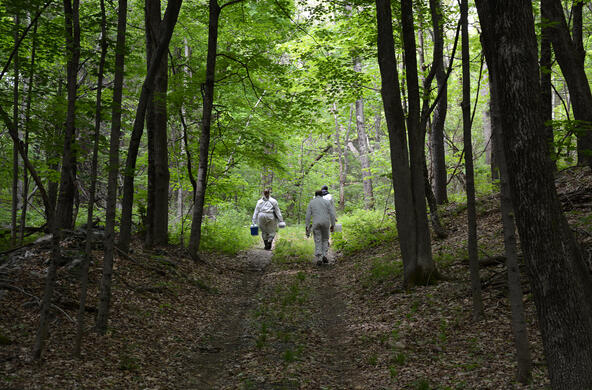A new study in New York reveals that ticks are more likely to be infected with several pathogens, not just the bacterium that causes Lyme disease. The ticks for the study were collected from Dutchess County.
People who are bitten by a blacklegged tick could be at higher risk of more than one infection. Felicia Keesing is a biology professor at Dutchess County-based Bard College and co-author of a new study.
“The most important finding, we found, is that ticks are almost twice as likely to be infected with two pathogens -- the bacterium that causes Lyme disease and the protozoan that causes babesiosis -- than we would have expected,” says Keesing.
She says nearly 30 percent of the ticks were infected with the agent of Lyme disease. One-third of these were also infected with at least one other pathogen. The agents of Lyme disease and babesiosis were found together in 7 percent of ticks.
“First we’re trying to get the word out to public health professionals and the public that this is something they need to be aware of with this new clarity about the magnitude of the problem,” Keesing says. “The other thing we’re doing is continuing to survey for other emerging pathogens, some of them much less well known than these ones that the public at this point have heard a lot about.”
Such as?
“Well, we’re interested in a couple of other borrelia species. Borrelia is the genus of the bacterium that causes Lyme disease, but there are some other species in that same group that are known to cause human disease but are poorly understood,” says Keesing. “So my lab is currently looking at those other species of borrelia to see if they’re found in this area and how common they are and, similar to this study, to see if ticks are co-infected with those at unexpected rates.”
The researchers, including some from the Millbrook-based Cary Institute of Ecosystem Studies, collected thousands of blacklegged ticks from more than 150 sites in Dutchess County, an area with a high incidence of tick-borne illnesses. They also collected ticks that had fed on different kinds of wildlife, including birds, rodents, opossums, and raccoons. Michelle Hersh is an assistant professor of biology at Sarah Lawrence College in Westchester County and lead author of the study. She says mice and chipmunks are critical reservoirs for the two pathogens, so ticks that have fed on these animals are more likely to be co-infected.
Democratic state Assemblymember Didi Barrett calls the study results frightening.
“It’s more important that legislation like ours that just passed that doctors have the ability and the opportunity without risk of someone looking over their shoulder to make the best decisions possible for their patients,” says Barrett.
Barrett authored the bill that prohibits the investigation of any claim of medical professional misconduct based solely on treatment that is not universally accepted by the medical profession, such as longer-term antibiotic treatment for chronic Lyme disease. Republican Kemp Hannon sponsored the bill in the Senate, where Democrat Terry Gipson was a co-sponsor. The legislation awaits Governor Andrew Cuomo’s signature. Gipson says the legislation provides a foundation for another bill.
“And the next step that we’re hoping to really tackle is helping pass legislation that will finally hold insurance companies accountable for covering the costs of all medical bills associated with long-term, tick-borne illness disease,” says Gipson.
Meanwhile, Barrett says the public education component needs to be greater. She also praised the work of the Senate Task Force on Lyme and Tick-Borne Diseases, which earlier in June released recommendations for a state action plan to enhance research, prevention, diagnosis and treatment for tick-borne illnesses. Gipson, too, commended the work, but criticized partisanship.
Meanwhile, for Bard’s Keesing, there is a major issue to be addressed.
“The focal problem is the abundance of ticks. So my interest, and I think I share this with a lot of people, is how do we get the kinds of large-scale, replicated studies to look at ways to reduce tick abundance that are really needed.”
Co-Infection of Blacklegged Ticks with Babesia microti and Borrelia burgdorferi Is Higher than Expected and Acquired from Small Mammal Hosts Michelle H. Hersh, Richard S. Ostfeld, Diana J. McHenry, Michael Tibbetts, Jesse L. Brunner, Mary E. Killilea, Kathleen LoGiudice, Kenneth A. Schmidt, Felicia Keesing







